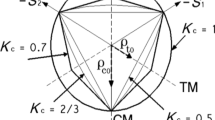Abstract
This paper presents an analytical model for simulating the bond between steel and concrete, in precast prestressed concrete elements, during the prestressing force release. The model establishes a relationship between bond stress, steel and concrete stress and slip in such concrete structures. This relationship allows us to evaluate the bond stress in the transmission zone, where bond stress is not constant, along the whole prestressing force release process. The model is validated with the results of a series of tests, considering different steel indentation depths and concrete covers and is extended to evaluate the transmission length. This capability has been checked by comparing the transmission length predicted by the model and one measured experimentally in two series of tests.




















Similar content being viewed by others
References
www.worldsteel.org and www.eurofer.org. Consulted on June 2008
FIB (2000) Bond of reinforcement in concrete. FIB bulletin 10, International Federation for Structural Concrete (fib), Laussane, Switzerland, 427 pp
Janney JR (1954) Nature of bond in pretensioned prestressed concrete. ACI J 25(9):717–736
Tepfers R (1973) A theory of bond applied to overlapped tensile reinforcement splices for deformed bars, 2nd edn. Chalmers University of Technology, Division of Concrete Structures, Göteborg, Sweden, Publication 73:2, 328 pp
Tepfers R, Olsson PÅ (1992) Ring test for evaluation of bond properties of reinforcing bars. In: Bond in concrete: from research to practice, vol 1. Riga Technical University and CEB, Riga, Latvia, pp 1-89–1-99
Cairns J, Johns K (1995) The splitting forces generated by bond. Mag Concr Res 47:153–165
Gálvez JC, Benítez JM, Tork B, Casati MJ, Cendón DA (2009) Splitting failure of precast prestressed concrete during the release of the prestressing force. Eng Fail Anal 16:2618–2634
Gambarova PG, Rosati GP (1996) Bond and splitting in reinforced concrete: test results on bar pull-out. Mater Struct 29:267–276
Abrishami H, Mitchell D (1992) Simulation of uniform bond stress. ACI Mater J 89(2):161–168
Gustavson R (2004) Experimental studies of the bond response of three-wire strands and some influencing parameters. Mater Struct 37:96–106
den Ujil JA (1992) Bond and splitting action of prestressed strand. In: Bond in concrete: from research to practice, vol 2. Riga Technical University and CEB, Riga, Latvia, pp 2-79–2-88
Gambarova PG, Rosati GP, Zasso B (1989) Steel-to-concrete bond after concrete splitting: constitutive laws and interface deterioration. Mater Struct 22(131):347–356
Benítez JM (2006) Estudio de la interacción entre el alambre preteso y el hormigón durante la transmisión de la fuerza de pretensado (in Spanish), PhD Thesis, Universidad Castilla La Mancha, Spain, p 219
Ogura N, Bolander JE, Ichinose T (2008) Analysis of bond splitting failure of deformed bars within structural concrete. Eng Struct 30(2):428–435
Jendele L, Cervenka J (2006) Finite element modeling of reinforcement with bond. Comput Struct 84(28):1780–1791
Malvar J (1993) Bond of reinforcement under controlled confinement. ACI Mater J 89:593–601
Abrishami H, Mitchell D (1993) Bond characteristics of pretensioned strand. ACI Mater J 90(3):228–235
Tassios T, Bonataki E (1992) Experimental analysis of the bond behaviour of prestressed tendons. In: Bond in concrete: from research to practice, vol 1. Riga Technical University and CEB, Riga, Latvia, pp 2-29–2-37
Noghabai K (1999) Discrete versus smeared versus element-embebed crack models on ring problems. J Eng Mech 125(3):307–315
den Uijl JA, Bigaj AJ (1996) A bond model for ribbed bars based on concrete confinement. HERON 41(3):201–226
van der Veen C (1991) Splitting failure of reinforced concrete at various temperatures. In: van Mier JGM, Rots JG, Baker A (eds) Fracture processes in concrete, rock and ceramics. RILEM, E & FN Spon, London, pp 941–949
RILEM-RPC6 (1994) Specification for the test to determine the bond properties of prestressing tendons, 1979. RILEM Recommendations for the Testing and Use of Construction Materials, E & FN Spon, pp 241–247
CEB-FIP (1990) Model code 1990, final draft. Comité Euro-International du Béton y Fédération Internationale de la Précontrainté
Abrishami HH, Mitchell D (1996) Influence of splitting cracks on tension stiffening. ACI Struct J 93(6):703–710
Russell BW, Burns NH (1997) Measurement of transfer lengths on pretensioned concrete elements. J Struct Eng 123(5):541–549
Oh BH, Kim ES (2001) Realistic evaluation of transfer lengths in pretensioned, prestressed concrete members. ACI Struct J 97(6):821–830
Acknowledgements
The authors gratefully acknowledge the financial support for the research provided by the Spanish Ministerio de Ciencia e Innovación under grant BIA-2008-03523 and by the Ministerio de Fomento under grants MFOM-2004/9 and MFOM-01/07.
Author information
Authors and Affiliations
Corresponding author
Rights and permissions
About this article
Cite this article
Benítez, J.M., Gálvez, J.C. Bond modelling of prestressed concrete during the prestressing force release. Mater Struct 44, 263–278 (2011). https://doi.org/10.1617/s11527-010-9625-5
Received:
Accepted:
Published:
Issue Date:
DOI: https://doi.org/10.1617/s11527-010-9625-5




